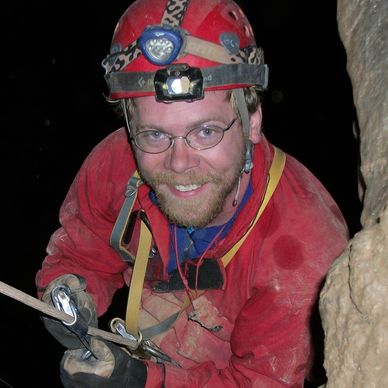CHL will be closed December 15, 2025 - January 2, 2026. Happy Holidays!
Crawford Hydrology Research Grant Awardees
Sarah Arpin, University of Kentucky
Matt Tomlinson, Smoky Mountain Grotto
Sarah Arpin, University of Kentucky
.jpg/:/cr=t:0%25,l:13.07%25,w:56.25%25,h:100%25/rs=w:388,h:388,cg:true)
Sarah Arpin graduated from Creighton University in 2007 with B.A. in Political Science and earned an M.S. in Geosciences from Western Kentucky University in 2013. While earning a certificate in GIS, Arpin worked as a wellsite geologist for Columbine Logging. In 2021, Ms. Arpin entered the Philosophy and Geological Sciences Ph.D. program at the University of Kentucky and began working as a Geologist for the Kentucky Geological Survey. Her dissertation research, entitled "Hydrogeology of the Silvertip Karst, Bob Marshall Wilderness Area, Montana" investigates the hydrogeology of a remote alpine karst system and has implications for issues of critical importance to society and the environment: groundwater availability, climate change, and landscapes and ecosystems that are largely undisturbed by human impact.
Ben Miller, Smoky Mountain Grotto
Matt Tomlinson, Smoky Mountain Grotto
Sarah Arpin, University of Kentucky

Ben Miller is a caver in Mount Juliet, Tennessee who originally hails from the Missouri Ozarks. Ben has been caving for over 30 years, though cave mapping and karst hydrology are his primary motivations in the sport. Ben is a karst hydrologist by training, who spends many of his weekends tracing the underground pathways of karst streams. Ben is also an avid cave mapper, having mapped over 500 caves and drafted maps for over 350 individual caves. Ben’s interest in the study area began with the mapping of vertical caves near Dorton Knob and Grassy Cove but increased with the start of a project he co-led to determine the largest springs in Tennessee, which involved the monitoring of nearby Head of Sequatchie Spring.
Matt Tomlinson, Smoky Mountain Grotto
Matt Tomlinson, Smoky Mountain Grotto
Charles Capps, Tennessee Tech University

Matt Tomlinson is a caver out of Knoxville, Tennessee who has been involved with Tennessee project caving for over 10 years. An architect by training, Matt has contributed to both large scale international caving expeditions as well as leading surveys and ridgewalking efforts in several major caving areas along the Cumberland Plateau. Matt is also a prolific and accomplished cave photographer whose work has been featured in the NSS News, on National Park Service official websites, and in several scientific papers. Matt has led survey efforts on Dorton Knob and Hinch Mountain for years, mapping miles of previously undiscovered cave passages in order to better understand the complex karst geology and hydrology of the area.
Charles Capps, Tennessee Tech University
Charles Capps, Tennessee Tech University
Charles Capps, Tennessee Tech University

Charles Capps earned a B.S. in Geology at Tennessee Tech University. His senior thesis project, Qualitative Dye Tracing of Dry Hollow, Overton County, Tennessee, used fluorescent dye tracing techniques to delineate groundwater drainage basins on the Cumberland Plateau Escarpment in middle Tennessee. This research aided in a better understanding of the hydrology and addressed environmental issues in the region.
Emily Barry, University of Kansas
Charles Capps, Tennessee Tech University
Jake Tholen, Western Michigan University

Emily Barry graduated from the State University of New York (SUNY) at Oneonta, earning a B.S. in Geology in 2016. As an undergraduate, Emily studied lava flows in the Cascade Mountains. While earning a M.S. in Hydrogeology at the University of Kansas, Emily's research, Characterization of groundwater flow paths through merokarst in the N04d watershed of the Konza Prairie Long-Term Ecological Research Site in Northeastern Kansas, USA, used fluorescent dye tracing techniques to characterize the magnitude and direction of groundwater flow paths in the shallow merokarst aquifers of northeastern Kansas.
Jake Tholen, Western Michigan University
Charles Capps, Tennessee Tech University
Jake Tholen, Western Michigan University

Jake Tholen received a B.S. in Hydrogeology from the Lee Honors College of Western Michigan University. He has worked as a cave guide for the Tongass National Forest in Alaska and as a park ranger at Wind Cave National Park in South Dakota. A study abroad semester in New Zealand allowed him to explore caves and sinkholes on the South Island with the Canterbury Caving Group. Dr. Pat Kambesis and Dr. Rick Toomey advised Jake on an undergraduate thesis on karst hydrology, Karst Sub-basin Delineation via Dye Trace Study near Turnhole Bend, Mammoth Cave National Park, which aimed to identify drainage divides in the area east of Turnhole Bend in Mammoth Cave National Park.
Ben Tobin, Texas State University
Ben Tobin, Texas State University
Ben Tobin, Texas State University

Benjamin Tobin graduated from the University of New Hampshire, earning a B.A. in Earth Science in 2002. He then attended Western Kentucky University, earning a M.S. in Geoscience in 2007. While working on his M.S., he worked for the Bureau of Land Management in Wyoming managing a water quality and quantity monitoring network. He then spent 4 years working for Sequoia and Kings Canyon National Parks as the Assistant Cave Resource Specialist. Ben entered the Aquatic Resources Ph.D. program at Texas State University in the fall of 2009. His dissertation research, Understanding Flow Paths in Mountain Karst Systems: the Kaweah River Basin, Sequoia and Kings Canyon National Parks, California focused on quantifying groundwater flow paths in the Yucca Creek karst of the Kaweah River Basin in Sequoia and Kings Canyon National Parks,
California.
Crawford Hydrology Laboratory
1500 State Street, Suite 304, Bowling Green, Kentucky
Call: 270-745-3458 OR 270-745-9224